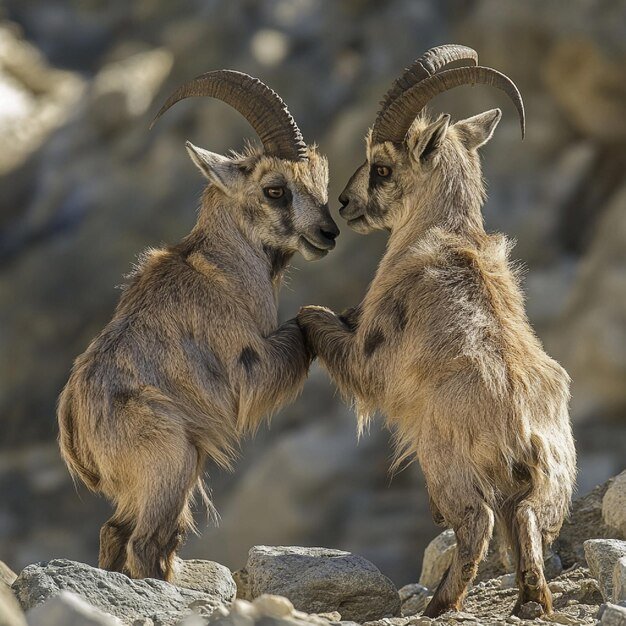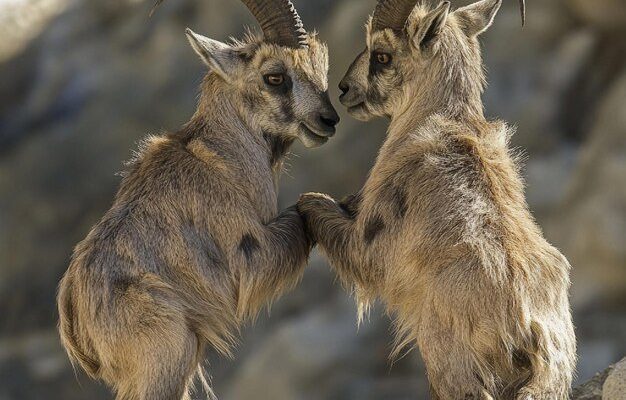
Imagine a clever puzzle waiting to be solved. That’s kind of like what the markhor faces daily; their environment is filled with challenges. From steep cliffs to tricky predators, these animals have to use their wits to navigate life. So, how smart is a markhor really? Let’s explore their cognitive abilities and behaviors together, learning just how these remarkable creatures adapt to their mountainous homes.
Understanding Markhor Behavior
Markhors are known for their remarkable adaptability, which plays a crucial role in their survival. Their natural habitat is often rugged and steep, making maneuverability key. These goats are not just built for the terrain; they’re also equipped with clever behaviors that help them thrive. For instance, during the mating season, males engage in fierce battles, showcasing their strength and competitive nature. This behavior isn’t just about winning mates; it also involves strategic decision-making about when to confront rivals and when to retreat—a sign of cognitive processing.
Markhor societies exhibit fascinating social structures as well. They typically form small groups, or “herds,” which provide safety in numbers. Within these herds, you’ll find intricate social dynamics. For example, you might see a dominant male leading the herd, while females and younger males follow. This leadership isn’t arbitrary; the dominant male’s experience and knowledge of the area allow him to make intelligent decisions regarding feeding and shelter.
The Markhor’s Problem-Solving Skills
You might be surprised to learn that markhors excel in problem-solving, especially when it comes to finding food or escaping danger. Their diet mainly consists of grasses, herbs, and shrubs, which can be quite hard to reach in their rocky environment. To access food in challenging locations, markhors have been observed using a variety of techniques, including climbing steep rock faces and navigating tricky terrain. This ability to strategize about food and find creative solutions demonstrates their intelligence quite clearly.
When faced with a predator, markhors display quick thinking. For instance, if they spot a threat, they won’t just run blindly into the wild. Instead, they often assess the situation, using their keen eyesight to evaluate where to take cover or how to escape. This level of awareness not only helps them avoid danger but also indicates a high level of cognitive functioning.
Communication Among Markhors
Markhors have their own way of communicating, which adds another layer to their intelligence. They use a series of vocalizations, body movements, and even scents to convey messages. For example, during the mating season, males grunt loudly to attract females and assert dominance. These sounds can carry over long distances, showing how important communication is to their social structure.
Additionally, markhors use body language to signal their feelings to one another. Whether it’s a playful nudge among kids or a more aggressive stance from a dominant male, their ability to read and respond to these signals indicates a high level of social intelligence. It’s almost like watching a conversation unfold in the wild—fascinating, right?
Adaptation to Environment
The markhor’s intelligence truly shines when you look at how they adapt to their environment. These goats are well known to live in some of the most challenging terrains on the planet, including the harsh landscapes of Afghanistan, Pakistan, and Tajikistan. Their ability to thrive in these conditions shows not only physical adaptability but also astute cognitive abilities.
For instance, during the winter months, when food sources become scarce, markhors adapt their foraging habits. They learn which areas provide the best access to food and migrate accordingly. This seasonal adjustment requires memory and critical thinking, showcasing their ability to gather knowledge from their surroundings and apply it to their lives.
Diet and Foraging Strategies
Markhors are herbivorous grazers, meaning their diet consists mainly of plant material, but it’s not as simple as just munching on grass. They have to be strategic about what they eat and when. In different seasons, the availability of food changes, pushing them to continually innovate their foraging strategies.
During the spring and summer, markhors eat a variety of plants, including tender shoots and leaves. In contrast, as winter approaches, they dig through the snow to reach hidden vegetation. This adaptability isn’t just instinctive; it requires problem-solving skills. It’s as if they’re conducting a treasure hunt every day, figuring out where to find their next meal amidst changing landscapes.
Role in Ecosystem
Markhors play a significant role in their ecosystem, connecting various elements of the food web. Their grazing habits help manage plant growth, promoting biodiversity. By feeding on specific plants, they maintain the balance within their habitat—something that reflects a deep understanding of their environment.
This ecological role also highlights their interactions with other species. For instance, their presence influences the populations of other herbivores and even predators. By understanding their place in the ecosystem, markhors showcase a level of awareness that goes beyond mere existence. They contribute to a larger system, making them an integral part of their environment.
Conservation and Future Challenges
Despite their fascinating cognitive abilities, markhors face many challenges today. Habitat loss, poaching, and climate change threaten their populations. Understanding their behavior and intelligence is crucial for conservation efforts. By promoting awareness, we can help ensure that these remarkable animals continue to thrive for future generations.
Conservation strategies often involve protecting their natural habitats and implementing anti-poaching laws. These efforts are not just about saving a species; they’re about preserving a complex web of life that includes the markhor. When we recognize the intelligence and adaptability of these goats, we start to see the bigger picture—one that needs our support.
In conclusion, the markhor is not just another wild goat; it’s a fascinating creature with remarkable cognitive abilities and behaviors that help it thrive in a challenging environment. From their problem-solving skills and social communication to their role in the ecosystem, markhors prove that intelligence comes in various forms. By understanding and appreciating their unique traits, we take an essential step toward protecting these incredible animals and the ecosystems they inhabit.

